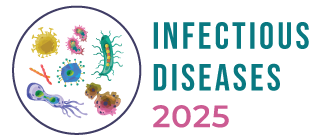Infectious Diseases
Infectious Diseases 2025

Royal Surrey County Hospital, UK
Abstract:
Background
Costo-chondral septic arthritis is exceptionally rare, only described a handful of times, most often in intravenous drug users. More common is septic arthritis of the costoclavicular and sternoclavicular joints, representing less than 1% of all bone and joint infections.[1, 2] Infection of these joints is often via haematogenous spread, most commonly seen in IVDU patients with other risk factors such as distant site of infection, diabetes mellitus and infected central venous catheter.[3] Local trauma or surgery to the joint may provide a substrate for infection but is not necessary for this condition to develop. Common causative organisms include Staphylococcus aureus, Pseudomonas aeruginosa and Brucella melitenis.[2] We report a case occurring in a diabetic man, with no other predisposition.
Case presentation
A 53-year-old male presented initially with chest pain to the Emergency Department (ED) was treated with oral antibiotics for a presumed community acquired pneumonia. On representation to ED and further imaging with an MRI, he was found to have a 4.7 cm rim-enhancing collection deep to the right first costochondral joint and overlying the pleural surface. Aspiration from the joint was cultured and grew Staphylococcus Aureus, with no clear source for this infection. The patient underwent thoracic surgery to debride the joint and had a long hospital stay. Fortunately, he managed to return to his day-to-day life following this serious infection.
Conclusion
Septic arthritis of a costochondral joint is exceptionally rare, especially in an immunocompetent patient like in this case, with the only other risk factor being diabetes. Usually, implicated joints are larger synovial joints such as the knee or the hip. Additionally, there were very few clues as to the cause given the presentation was primarily of chest pain, which represented a diagnostic challenge. This case highlights the importance of maintaining a broad differential for chest pain presentations and how timely diagnosis and management could prevent long-term effects of the infection.
Biography:
Shinjal Sharma is affiliated with the Respiratory Department at Royal Surrey County Hospital, Guildford, Surrey, UK.
